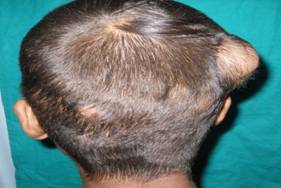Epidemiological study of Appendageal skin tumors in tertiary health centre in central India
Abstract
Introduction: Cutaneous appendageal tumours are a large diverse group of tumours that are commonly classified according to their state of appendageal differentiation- eccrine, apocrine, follicular and sebaceous. Most appendageal tumors are relatively uncommonly encountered in routine clinical practice. Though some of the appendageal tumors (e.g. syringoma, nevus sebaceous) can be diagnosed clinically with ease but most of them have non-specific morphological appearance and their diagnosis is mainly based on histopathological characteristics.
Material and methods: It was a cross sectional descriptive study conducted in the department of dermatology, Chirayu medical college and hospital, Bhopal. A total of 90 patients attending department of dermatology were screened out for appendageal tumors and those 60(66.6%) who were confirmed by histopathological examination of lesional biopsy were included in the study.
Results: On the basis of differentiation of tumors, sweat gland tumors were the most common appendageal tumors in our study (79.8%) followed by follicular tumors (11.6%), sebaceous were 8.3%. On individual tumor basis, syringoma constituted maximum numbers of cases (56.6%) followed by multiple trichoepitheliomas and hidrocystoma (both 11.6%). Face was the commonest site of predilection 40(66.6%) followed by scalp 12(20%).
Conclusion: Appendageal tumors are relatively uncommon and constitute very small proportion of dermatological disorders. Though clinical appearance might help in diagnosing common appendageal tumors but histological examination remains the gold standard method in diagnosing clinically suspicious lesions.
Downloads
References
2. Mackie RM, Calonje E. Tumors of the Skin Appendages. In: Burns T, Breathnach S, Cox N, Griffiths C, editors. Rook's Textbook of Dermatology. 7 th edition. London: Blackwell Publishing Company; 2004. p. 1-34.
3. Stantaylor R, Perone JB, Kaddu S, Kerl H. Appendage Tumors and Hamartomas of the Skin. In: Wolff K, Goldsmith L, Katz S, Gilchrest BA, Paller AS, Leffell DJ, ed. Fitzpatrick's Dermatology in General Medicine. 7 th edition. New York: McGraw Hill; 2008. p. 1068-87.
4. Saha A, Das NK, Gharami RC, Chowdhury SN, Datta PK. A clinico-histopathological study of appendageal skin tumors, affecting head and neck region in patients attending the dermatology OPD of a tertiary care centre in Eastern India. Indian J Dermatology 2011; 56:33-6. [PubMed]
5. Samaila M. Adnexal skin tumors in Zaria, Nigeria. Ann Afr Med 2008; 7:6-10. [PubMed]
6. Jindal U, Patel R. Study of adnexal tumors of the skin: a three year study of 25 cases. The internet journal of pathology. 2012; 13; 3.
7. Sharma A, Deepak G. Paricharak, Nigam JS, Rewri S, Soni PB, Omhare A, Sekar P. Histopathological study of skin adnexal tumours-Institutional study in south India. Journal of Skin Cancer. 2014;1:1-4. [PubMed]
8. Nair PS. A clinicopathologic study of skin appendageal tumors. Indian J Dermatol Venereol Leprol 2008;74:550.



 OAI - Open Archives Initiative
OAI - Open Archives Initiative


